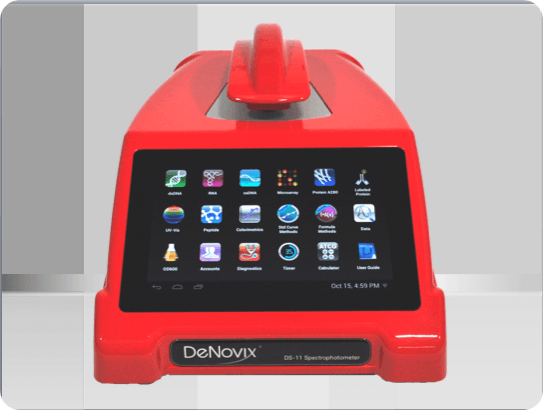Microvolume absorbance spectrophotometers are ubiquitous in laboratories and analytical facilities concerned with protein analysis, extraction and purification. The two leading technologies for protein concentration measurements in biochemistry and life science applications are the DS-11 Series Spectrophotometer / Fluorometer from DeNovix and the NanoDrop™ family of instruments from Thermo Fisher Scientific. Each of these analytical tools enables protein quantification and quality measurements with excellent limits of detection.
The Thermo Fisher NanoDrop™ family of instruments pioneered modern microvolume analysis techniques for protein concentration measurements in samples on the 1—2 microliter range (µL). Relying on surface tension of liquids, Thermo Fisher NanoDrop™ instruments utilize optical pedestals to stretch microvolume samples into a column and perform absorbance measurements.
The DeNovix DS-11 Series is an all-in-one microvolume UV-Vis spectrophotometer and fluorometer. This instrument boasts the most sensitive ultraviolet-visible (UV-Vis) analysis currently available, with full spectrum capabilities to facilitate rapid protein concentration measurements. The DS-11 Series uses a unique sample retention principle known as Bridge Testing™ verification that improves the accuracy of nano volume protein analysis.
In this blog post, DeNovix will explore the protein concentration capabilities of both instruments in more detail.
Benefits and Limitations of Thermo Fisher NanoDrop™ Technology for Protein Concentration
Thermo Fisher NanoDrop™ technologies perform protein concentration measurements using a pedestal measurement technique. A sample droplet is pipetted directly onto the spectrophotometer’s lower pedestal, a column is formed when the upper surface is brought in contact with the sample then drawn apart, relying on surface tension to maintain column integrity. The position of the upper pedestal is adjusted to set the pathlength (the distance through which the light will travel through the sample) and protein concentration measurements can subsequently be performed using a xenon flashlight and a linear charge-coupled device (CCD) array spectrometer.
The primary drawback of this technique is the potential for erroneous measurements due to sample column breakage. The Thermo Fisher NanoDrop™ spectrophotometer’s reliance on stretching samples is potentially problematic for protein samples where buffers used create low surface tension. Historically this has led to many labs considering microvolume analysis unsuitable for protein quantification.
Benefits of DeNovix DS-11 SmartPath™ Technology
By contrast, the DS-11 Series is engineered with SmartPath™ technology with Bridge Testing verification. This unique measurement system compresses the sample in contrast to stretching it, and does not rely on sample surface tension. It can also detect and automatically compensate for unbridged sample conditions in situ, ensuring the accuracy of protein concentration results.
The DS-11 FX+ is equipped with three distinct measurement modes suitable for protein concentration measurements, including: purified proteins; cell and tissue extracts and low concentration samples. These modes are:
- Protein A280: using a UV-Vis scan and measuring protein absorbance at of 280 nm
- Colorimetrics: measuring protein concentration using common assays such as Bradford, BCA and Pierce 660
- Fluorescent Protein Assays: for sensitive and specific protein quantification
Microvolume Protein Concentration with DeNovix
The DS-11 Series from DeNovix was established by some of the key minds behind NanoDrop™ Technologies Inc. If you would like more information about Microvolume Analysis of Protein Samples, please do not hesitate to contact us directly.
NanoDrop™ and NanoDrop™ One are registered trademarks of Thermo Fisher Scientific and its subsidiaries and are used for identification and references purposes only. DeNovix, DeNovix products and this website are not endorsed by Thermo Fisher Scientific.



